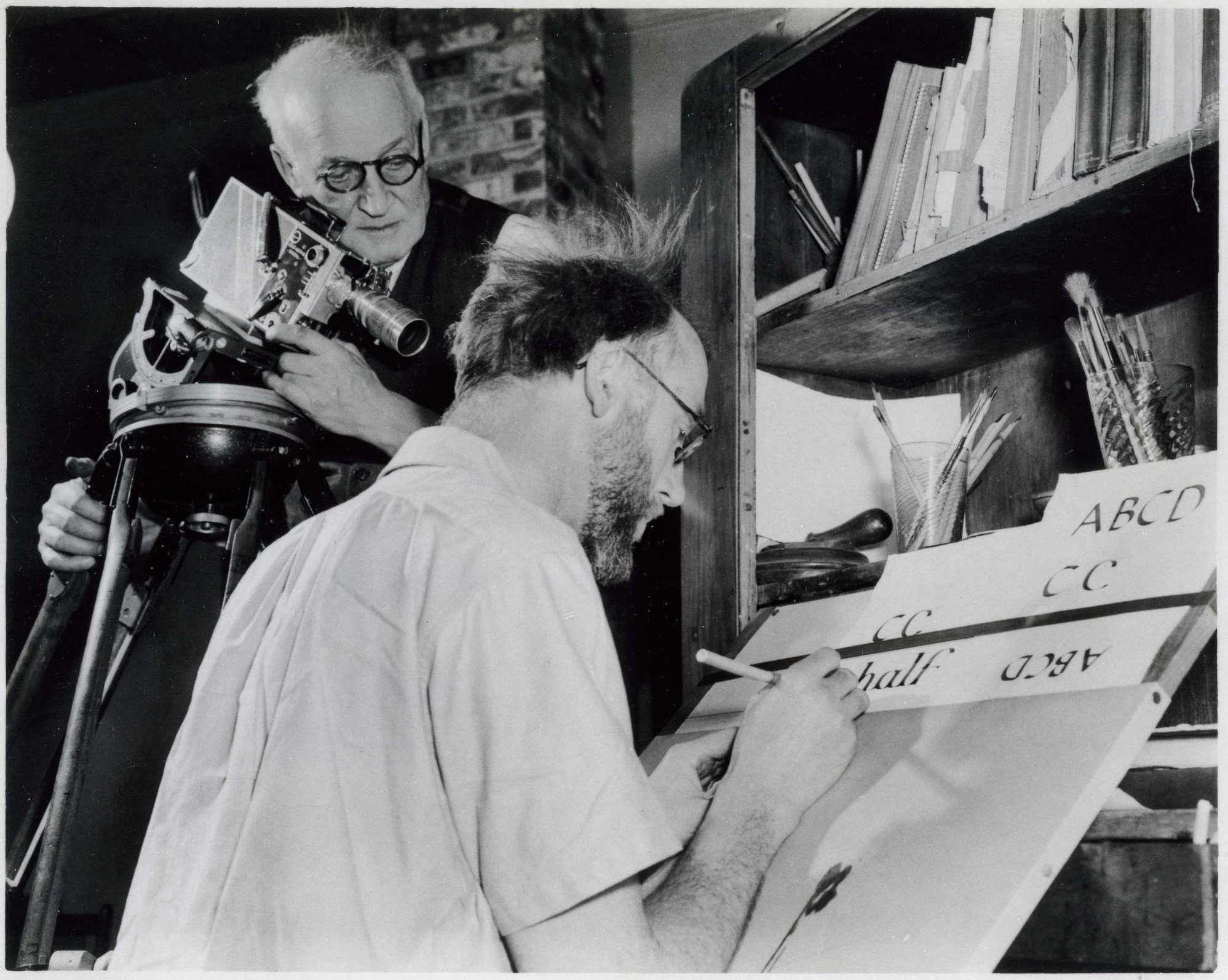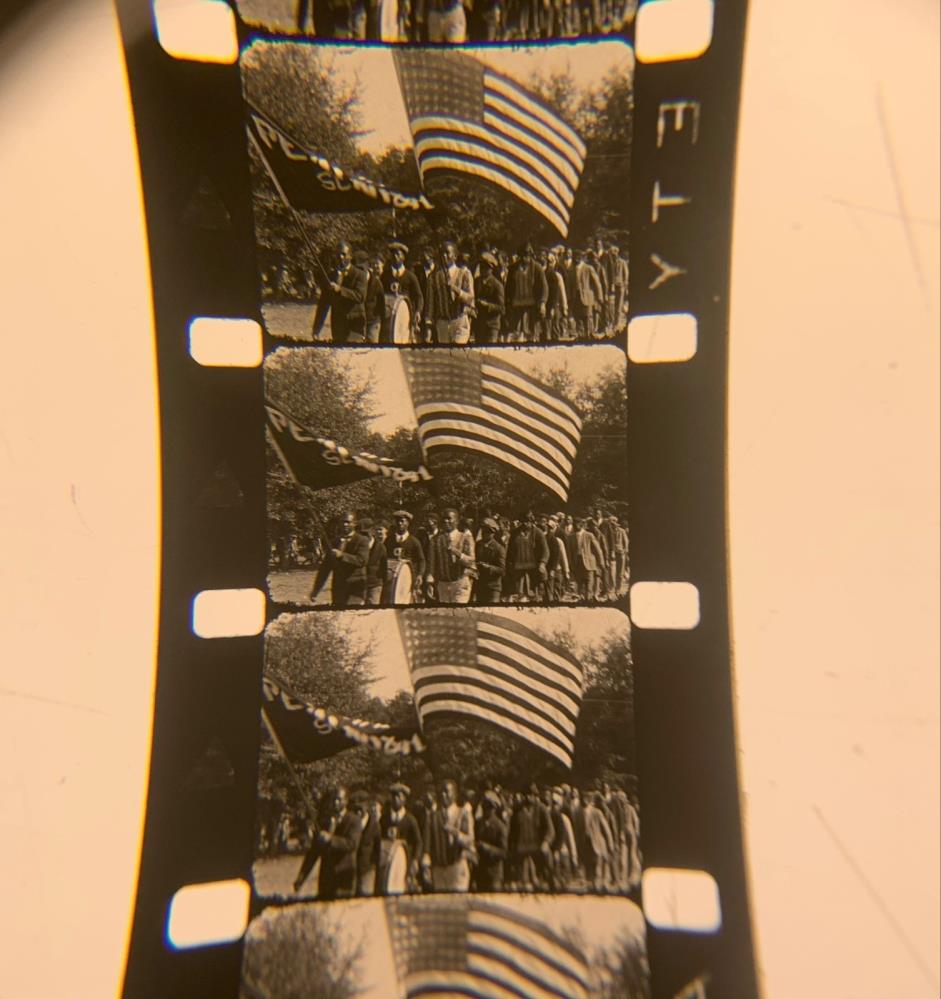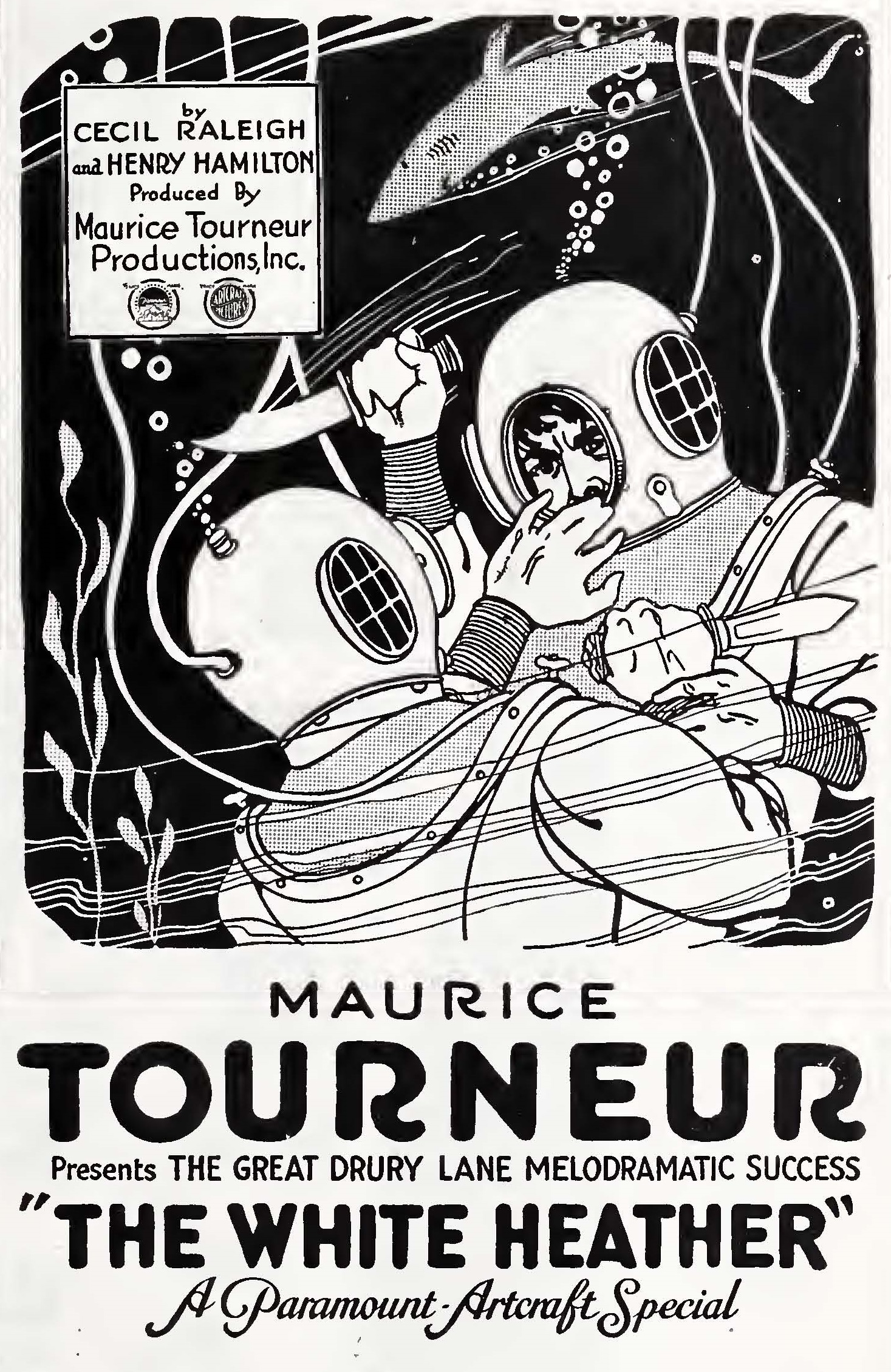- Films Preserved Through the NFPF
- 2014 Federal Grant Winners
- 2015 Federal Grant Winners
- 2016 Federal Grant Winners
- 2017 Federal Grant Winners
- 2018 Federal Grant Winners
- 2019 Federal Grant Winners
- 2020 Federal Grant Winners
- 2021 Federal Grant Winners
- 2022 Federal Grant Winners
- 2023 Federal Grant Winners
- 2024 Federal Grant Winners
- 2025 Federal Grant Winners
2023 Federal Grant Winners
-
 Robert J. Flaherty filming calligrapher John Howard Benson. After Flaherty's death some of the footage was released as the short film Cutting a Quill (1959), to be preserved by the Rhode Island School of Design with NFPF support.
Robert J. Flaherty filming calligrapher John Howard Benson. After Flaherty's death some of the footage was released as the short film Cutting a Quill (1959), to be preserved by the Rhode Island School of Design with NFPF support. - 4-H Boys Camp (1961), promotional footage with scenes of chainsaw and bows (North Carolina State University).
- 4-H Camp Outtakes (early 1960s), scenes of crafts and dancing in a North Carolina mountain camp (North Carolina State University).
- 4-H Forestry Field Day (1930s), educational film used for forestry demonstrations and club meeting training (North Carolina State University).
- 4-H Millstone Camp (1961), scenes of swimming, canoeing, and tree-planting at the North Carolina camp founded in 1939 (North Carolina State University).
- The American Vision (1965), educational film using the gallery’s collection to trace the development of American painting, created by J. Carter Brown and narrated by Burgess Meredith (National Gallery of Art).
- Atlanta Club Honors Mayor William B. Hartsfield (1961), footage of a local social club fêting the city’s longest-serving mayor (Atlanta History Center).
- Beyond Measure (1994), Herb E. Smith’s documentary on the loss of thousands of coal mining jobs in Appalachia and the efforts of its citizens to rebuild their communities (Appalshop Archive).
- Bitter Melons (1971), documentary by John Marshall on the music and dance of a band of the /Gwi San people of southern Africa (Documentary Educational Resources).
- Bottle Feeding Dwarf Leopards and Tayras, British Guiana (1936), documentation of a research expedition led by ichthyologist Gloria Hollister (Wildlife Conservation Society).
- Buck Dancer (1965), Beth Lomax Hawes’ film of Mississippi fife player Ed Young playing and dancing (National Museum of Natural History, Smithsonian Institution).
- Camp Syracuse (1917), footage filmed during World War I at the military base located on the New York State Fair grounds (Onondaga Historical Association).
-
 The Penn School Collection (1925–41) will be preserved by the University of North Carolina at Chapel Hill with NFPF support.
The Penn School Collection (1925–41) will be preserved by the University of North Carolina at Chapel Hill with NFPF support. - Children of Emmonak (ca.1971), footage of young residents at play in the Yu’pik village of Emmonak, Alaska (Alaska Moving Image Preservation Association).
- Construction of the San Francisco–Oakland Bay Bridge (1933–37), footage shot by Ken Allen, staff photographer of the Hills Bros. Coffee Company (National Museum of American History, Smithsonian Institution).
- Council Meeting: Land Claims (ca.1972), footage of Yu’pik villagers requesting information on the Alaska Native Claims Settlement Act of 1971 (Alaska Moving Image Preservation Association).
- Cutting a Quill (1959), documentary on calligrapher John Howard Benson, assembled from footage shot by Robert Flaherty and Richard Leacock (Rhode Island School of Design).
- David Scott at the 50th Indianapolis 500 (1966), color footage shot by the NASA astronaut and seventh person to walk on the Moon (Emory University).
- Demon Lover Diary (1980), Joel DeMott’s caustic behind-the-scenes documentary on the production of a low-budget horror film (Chicago Film Society).
- Department of Tropical Research Activities, Bermuda (1928–29), documentation of Wildlife Conservation Society expeditions by author Elswyth Thane (Wildlife Conservation Society).
- Dulles International Airport Engineering Progress Report, Part 2 (1961), produced by the Federal Aviation Administration for internal documentation (National Air and Space Museum, Smithsonian Institution).
- Etta and Claude Barnett Travel Films of Africa (1950s), footage of cultural exchanges fostered by actress/civil rights activist Etta Motten and her husband, Associated Negro Press founder Claude Barrett (National Museum of African American History and Culture, Smithsonian Institution).
- Expedition to China to Collect Pan-dah and Pan-dee (1941), footage of the trip to collect two pandas gifted to the Bronx Zoo by Madame Chiang Kai-shek (Wildlife Conservation Society).
- Festival in Washington (1968–69), documentary on the second annual Festival of American Folklife, held on the National Mall in 1968 (Center for Folklife and Cultural Heritage, Smithsonian Institution).
- Flying Fish at Bathsheba Beach, Barbados (1938–39), documentation of research by ichthyologist Gloria Hollister (Wildlife Conservation Society).
- The Four Pillars of Income (1939), sponsored film on the benefits of crop rotation to farmers around Clarksville, Tennessee, created by the local bank (Knox County Public Library).
- Frank Kameroff Moves Into a New Home (1971), filmed protest by a Yu’pik elder on inadequate housing administered by the state government to the residents of Emmonak, Alaska (Alaska Moving Image Preservation Association).
- Freewheelin’ (1976), sponsored film from B.F. Goodrich, documenting the 1976 “National Truck-In” at Bowling Green, Kentucky (Hagley Museum & Library).
- Georgia Sea Island Singers (1964), performances of the renowned gospel group filmed by Beth Lomax Hawes (National Museum of Natural History, Smithsonian Institution).
- Growing a Flower Garden from Seed (1950), sponsored film produced by the National Garden Bureau and directed by Victory Garden Manual author James H. Burdett (Archives of American Gardens, Smithsonian Institution).
- Harold is Gone (1988), Bill Stamets’ documentation of the funeral of Chicago mayor Harold Washington (Chicago Film Archives).
- Hartsfield’s Mayoral Career (ca.1940–71), retrospective of William B. Hartsfield’s six terms as mayor of Atlanta (Atlanta History Center).
- Immigrants in Casablanca, Belgium and Holland Tourist Scenes (1954–56), footage of transit camps for Jews emigrating to Israel (American Jewish Joint Distribution Committee).
- In the Best Interests of Children (1977), documentary examination of the issues faced by lesbian mothers in keeping custody of their children (UCLA Film & Television Archive).
-
 The Ralph Stanley Story (2000) will be preserved preserved by Appalshop Archives with NFPF support.
The Ralph Stanley Story (2000) will be preserved preserved by Appalshop Archives with NFPF support. - Israel (1954–57), footage of arriving refugees, the opening of a JDC-sponsored home for the aged, and a kibbutz wedding attended by David Ben Gurion (American Jewish Joint Distribution Committee).
- Italy, Yugoslavia, and Israel (1955), travel footage filmed by Executive Vice Chairman Moses Leavitt (American Jewish Joint Distribution Committee).
- Kites and Other Tales (1975), educational film by Alan Ohashi on kite-making and kites in Asian folklore (Visual Communications).
- Lying Wives (1925), independently produced silent melodrama starring Clare Kimball Young as the scheming spouse (George Eastman Museum).
- Mayor Hartsfield’s 1940 Campaign, Parts I & II (1940), promotional films for the reelection of Atlanta’s mayor (Atlanta History Center).
- Mayor Hartsfield’s Funeral (1971), filmed procession through downtown Atlanta, with eulogy by Mayor Sam Massell (Atlanta History Center).
- Mayor Hartsfield and Margaret Mitchell Selling War Bonds (ca.1940–45), footage of Atlanta’s longest-serving mayor alongside the author of Gone with the Wind (Atlanta History Center).
- Mayor Marvin—Syracuse, a Successful City (1941), sponsored film promoting Mayor Rolland Marvin, who served the New York city from 1930 to 1941 (Onondaga Historical Association).
- Mississippi Triangle (1984), examination of the intersections and power relations of racial communities in the Mississippi Delta region, using three film crews, each from a different ethnic community (Third World Newsreel).
- Novo Dextro: Purity and Danger (1982), Bill Stamets’ documentary on an American Nazi Party rally in Chicago and its protesters (Chicago Film Archives).
- N/um Tchai: A Celebration of the Dance of the !Kung Bushmen (1969) John Marshall’s documentary of an all-night healing dance performed by the Ju/hoansi people of southern Africa (Documentary Educational Resources).
- Okefenokee Swamp (ca. 1950–60), footage of Atlanta mayor William B. Hartsfield on vacation in the wildlife refuge (Atlanta History Center).
- Once Upon a Hill There Was a School! (1963), subversive promotional film by Martin Lavut, sponsored by Washington University (Washington University in St. Louis).
- Peace Songs, Deer Songs, Tlingit Compositions (1959-68), footage of the last peace dances performed by the Tlingit community of Hoonah, Alaska (Huna Heritage Foundation).
- Penn School Collection (1925–41), home movies taken at the historic industrial school for African Americans on South Carolina’s Saint Helena Island (University of North Carolina at Chapel Hill).
- Pieces of a Dream (1974), Eddie Wong’s documentary on immigrant farm laborers who settled in the Sacramento River Delta town of Locke (Visual Communications).
- Pizza Pizza Daddy-O (1967), ethnographic film by Bess Lomax Hawes on playground singing games played by a group of African American fourth-grade girls in Los Angeles (National Museum of Natural History, Smithsonian Institution).
- The Ralph Stanley Story (2000), Herb E. Smith’s feature-length portrait of the bluegrass legend and his musical roots (Appalshop Archive).
- Rox Sox Disco Sux (1979), experimental documentary by Bill Stamets of Chicago’s notorious “Disco Demolition Night” (Chicago Film Archives).
- Rudy Lozano (1983), Bill Stamets’ examination of southside Chicago’s response to the murder of the Mexican American labor rights activist (Chicago Film Archives).
- Say Old Man Can You Play the Fiddle (1973), documentation by Beth Lomax Hawes of performances by bluegrass fiddler Earl Collins (National Museum of Natural History, Smithsonian Institution).
-
 Maurice Tourneur's The White Heather (1919), will be preserved by the San Francisco Silent Film Festival with NFPF support.
Maurice Tourneur's The White Heather (1919), will be preserved by the San Francisco Silent Film Festival with NFPF support. - Shades (1960), fictional short filmed on Rikers Island by City College of New York film students and staff for the NYC Department of Correction (Yale Film Archive).
- Some Problems of Women (1971), filmed discussion by five Yu’pik women on the difficulties of household economics and suggestions for changes to food stamps and other programs (Alaska Moving Image Preservation Association).
- The Story of a Smile (1952), JDC-sponsored film on a kindergarten in Tunisia whose staff use methods from the JDC’s Paul Baerwald School of Social Work (American Jewish Joint Distribution Committee).
- Sugar Boat and New Waterfalls, British Guiana (1936), documentation of a research expedition led by ichthyologist Gloria Hollister (Wildlife Conservation Society).
- Where’s Joe? (1972), warning to American steelworkers about foreign competition, co-sponsored by the United Steelworkers Union and several steel companies (Hagley Museum & Library).
- Where New Flowers Are Bred (1947–48), depiction of California flower farms, sponsored by the National Garden Bureau (Archives of American Gardens, Smithsonian Institution).
- The White Heather (1919), silent melodrama directed by Maurice Tourneur, climaxing in an underwater fight filmed through the Williamson Submarine tube (San Francisco Silent Film Festival).
- Wild Europe (1959), feature length wildlife documentary by Roger Tory Peterson (Roger Tory Peterson Institute).
